What you are trying to do is searching for "connected components" and
NetworX has itself a method for doing exactly that as can be seen in the first example on this documentation page as others has already pointed out on the comments.
Reading your question it seems that your nodes are on a discrete grid and the concept of connected that you describe is the same used on the pixel of an image.
Connected components algorithms are available for graphs and for images also.
If performances are important in your case I would suggest you to go for the image version of connected components.
This comes by the fact that images (grids of pixels) are a specific class of graphs so the connected components algorithms dealing with grids of nodes
are built knowing the topology of the graph itself (i.e. graph is planar, the max vertex degree is four). A general algorithm for graphs has o be able to work on general graphs
(i.e they may be not planar, with multiple edges between some nodes) so it has to spend more work because it can't assume much about the properties of the input graph.
Since connected components can be found on graphs in linear time I am not telling the image version would be orders of magnitude faster. There will only be a constant factor between the two.
For this reason you should also take into account which is the data structure that holds your input data and how much time will be spent in creating the input structures which are required by each version of the algorithm.
